(Help support this site! If you buy stuff through my links, your clicks and purchases earn me a commission from many of the retailers I feature, and it helps me sustain this site—as well as my menswear habit ;-) Thanks!)
Last year, as I fell deeper into this whole wristwatch thing, I wrote about the Seamaster Professional 300m—aka the Bond Seamaster. My favorite Swiss mechanical watch, I feel it’s an excellent every day piece. I’ve worn my dad’s off and on for nearly 20 years, and whenever it’s been in my possession, I’d wear it without ever taking it off. It’s comfortable enough to sleep while wearing, dressy enough for a suit, sporty enough for a tee and jeans, waterproof for when you shower or go swimming; truly a great all around watch.

Quoting from my first post briefly, here’s the origin story:
In 1993 Omega introduced this new watch, a dive watch intended to compete with the all-time king of the category, the Rolex Submariner. Omega had been making dive watches for decades, but this watch has the design language that put it most directly in competition with the Sub. Fortuitously for the brand, in 1995 Goldeneye costume director Lindy Hemming decided to give James Bond an Omega in that film—not a Rolex, as Ian Fleming had described Bond as wearing in the original 007 novels—because her father had served in the Royal Navy during the time that Seamasters were standard issue to servicemen. The resulting publicity made this watch instantly iconic and one of the best-selling watches of all time.
Beauty is in the eye of the beholder, of course, but I find the SMP300 to be more interesting and beautiful to look at than the Submariner. I understand the appeal of the Sub: it has a strong, virtually unchanged design for going on 70 years, with a utilitarian character true to its origin as a watch meant for real field use. But to me, it just looks like a piece of square metal. The Seamaster, on the other hand, has beautiful swooping curves, accentuated by scalloped edges on the bezel and those awesome twisted lyre lugs standard on most Omega sports watches since the ‘60s. In the same way I love barchetta breast pockets, curved open patch pockets and hand-made details on Neapolitan jackets, the curves of the SMP300m bring a human feel to its industrially produced steel chassis.

(Note: Most the model links to follow are to eBay searches, though you can find them elsewhere. eBay is good for finding pre-owned watches as they include a free-to-you authentication service, taking the risk out of buying from an individual seller. If you want to go purely up-and-up, look at authorized dealers like Mayors or Watches of Switzerland, which are both part of the same company, but of course their new watches will only be the currently available models. Both also sell pre-owned watches if you want to get a mostly new watch in great condition for less than retail without having to haggle, though both. You can go gray market through sites like WatchShopping.com too, where you get a new watch but sometimes without the warranty, but usually for less money. Chrono24 is popular as well but they have no built-in process for authentication; if you get a fake, you have to determine that for yourself and initiate a complaint). As always, I use affiliate links and may earn commission on purchases from some retailers you make after clicking them.

2006 Mid-Cycle Refresh
The original SMP300m (reference 2531.80 if you’re searching for one) sold in the millions thanks to its beautiful design and the cachet of James Bond, and it remained unchanged for 13 years. In 2006, they gave it what I’d call a mid-cycle refresh, which was featured on Daniel Craig’s wrist in his first outing as James Bond in Casino Royale. The reference 2220.80 (and 2221.80 for the quartz model, both referring to the 41mm version) swapped the all-printed dial of the original for applied indices, logo and word mark (the quartz model’s word mark is still printed). It makes for a slightly more luxe feel, without changing the overall character of the watch too much. It still sports the aluminum bezel (which will fade over time with exposure to sunlight), the subtle yet unique wave pattern dial, and everything else about the first version that made it so charming.
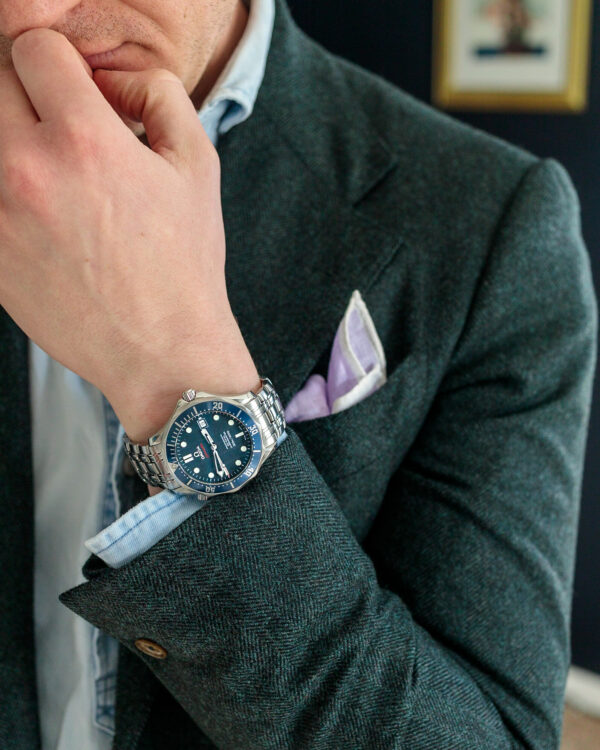
The 41mm size is just about perfect, and if you’re worried about wrist size, it wears smaller than it sounds on paper, in part thanks to how thin it is. My wrist is about 6.75” in circumference, and the watch doesn’t overwhelm it in the slightest. At 13mm thick, it’s fairly standard on paper, but in practice it wears thinner than that. If you go for the original 2531.80 model, it’s even thinner at 11.5mm thick.
This 2006 refresh is the watch I personally bought, and I have concluded that if you want a blue Seamaster 300m, out of all the watches past and present, this is the one to get. That, in part, has to do with the Co-Axial movement inside—a technology exclusive to Omega that I just love. A quote from my Aqua Terra review briefly summarizes:
The escapement of a watch is like its beating heart—it’s what is actually measuring time. The standard lever escapement has been in use for around 200 years; the coaxial escapement was invented in the 1970s, and improves on it by nearly eliminating friction, thus theoretically eliminating the need for lubricant (which breaks down over time), requiring less frequent maintenance and maintaining better accuracy over time. The two resources I found helpful in explaining this are this YouTube vid which shows a normal mechanical watch movement, and this Hodinkee article which explains the coaxial escapement and how it improves the traditional lever escapement.
I love the Co-Axial escapement in the same way I love the continuously variable transmission in my car: it’s an interesting, novel, superior innovation that replaces a ubiquitous design, and gives me joy every time I think about it. Not un-surprising to me: no car guys that I know care for the CVT (even though it’s banned by Formula 1 for being a better transmission design that would give unfair advantage and alter the character of the sport), and many self-styled watch aficionados likewise consider the Co-Axial escapement as an interesting oddity that’s perhaps intellectually curious but not something they have much time for. Go figure.
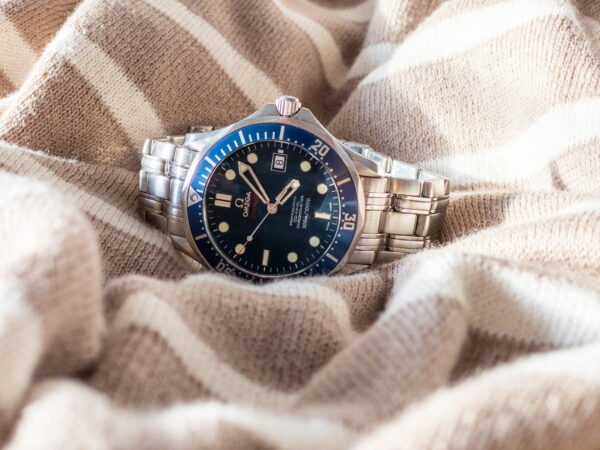
This 2006 refresh of the Seamaster 300m is my favorite because it straddles the line between the classic Brosnan era watch and the later generations by maintaining the subtler design, matte finish and perfect proportions of the original while introducing small luxe details with the applied logo, word mark and indices, and with a co-axial escapement inside to make it a uniquely Omega movement (I realize it is not an “in-house” movement like the later caliber 8×00’s are, but the escapement is still uniquely Omega).
I’m not touching on every model, size and color variation offered, so if you’re interested in this watch you can start with the reference numbers I’ve listed and go from there. On these original aluminum bezel editions, the standard 41mm size is the classic, but I’d also recommend looking at the 36mm model—they’re cheaper, still have excellent proportions and look no less manly for their smaller size (reference 2551.80 for the original, or 2222.80 for the co-axial mid-cycle model). Prince Harry was given one as a gift by his mother Diana in 36mm and he wears it to this day.

I’d also say don’t overlook the quartz models of the original if 1. you don’t want to mess with $500 service every 6-10 years, 2. you want to save a few hundred bucks up front and 3. the tick of quartz doesn’t bother you (as opposed to the smooth sweep of the seconds hand on a mechanical watch). Those reference numbers are: 41mm 2541.80 | 36mm 2561.80. And for the mid-cycle refresh it’s 41mm 2221.80 | 36mm 2223.80.
Second Generation, 2012 Ceramic Model (212.30.41.20.03.001)
In 2012, the second generation and first complete redesign of the watch came. They kept the size, but enlarged the numerals on the bezel. They introduced ceramic both on the bezel and on the dial—ceramic is a harder, completely color-fast material which is why it holds appeal. No longer would the bezels fade or scratch/dent easily as the old aluminum ones did.
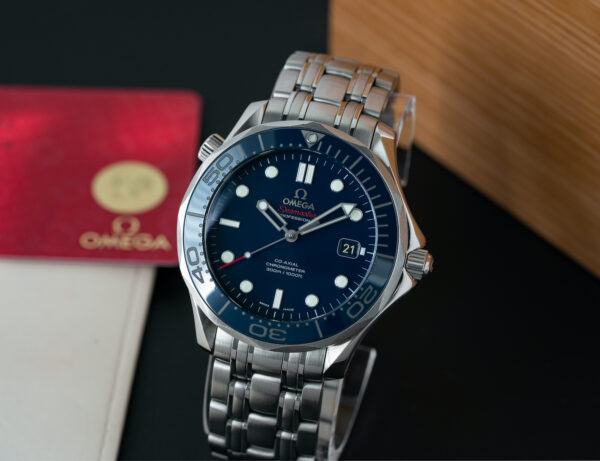
Unfortunately with the change to ceramic meant the dial lost its charming wave pattern, swapping it for shiny ceramic. Once again, beauty is in the eye of the beholder, but I’ve always found this generation’s design to be lacking; like a prototype that shouldn’t have been released. The proportions are off on account of the larger bezel track and larger numerals, the color on the blue version is strangely flat and lifeless, the dial lacks visual interest, and the indices around the bezel are weirdly low-contrast. This generation is worth skipping, to me. Which is a shame, because it still has the great 41mm case size that’s 13mm thick, which is so wearable, and the use of ceramic is a great upgrade. If you like this one and aren’t bothered by the same things I am, here’s a saved eBay search for the blue model of this watch.
Third Generation, The Wave Pattern Returns (210.30.42.20.03.001)
In 2018, the sins of gen 2 were addressed in a much more dramatic overhaul of the design. Ceramic is still the material of choice, but the flat dial was replaced with the re-introduction of a wave pattern, this time laser-etched at a much lower frequency and with larger spacing than the original. It’s a sharp throwback to the charm of the original while staying true to the new materials in use.
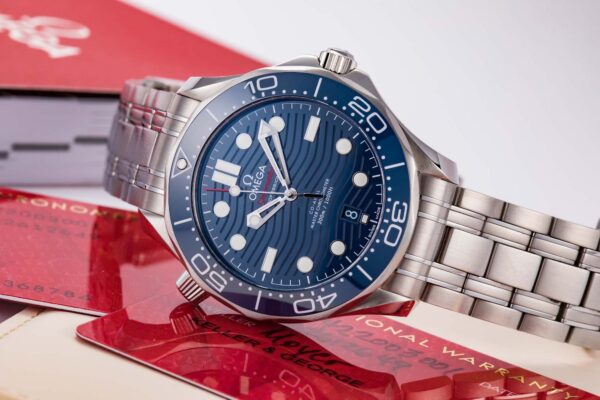
The indices grew in size, a common trend with modern watches, as did the overall case size to 42mm from 41mm, the thickness growing from 13mm to 13.5mm. The numerals on the bezel are a much higher contrast white enamel, making them more readable than gen 2, and the color on the blue model is a much more vibrant, saturated blue. It changes depending on the light, but regardless, it’s a much flashier color than any previous model.
Internally Omega uses an exclusive in-house movement (meaning, they developed it in-house from scratch, rather than adapting an off-the-shelf movement, which is what had been in every model of this watch since ‘93), which is nice in and of itself, but of particular importance for real-world usage that means it gained their “master chronometer” specification. That brings better accuracy, but most importantly, it brings anti-magnetism, which means you never have to think twice about placing this watch on your iPad or too close to the back of your new iPhone 12.
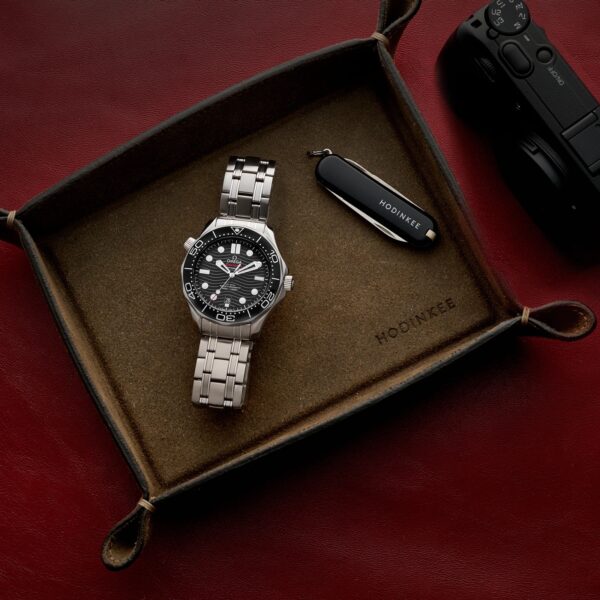
There have always been color choices for the SMP300, but this generation feels like Omega’s truly hit their stride in making attractive variations that feel part of the same collection. The traditional blue is gorgeous, but it’s the black model that speaks to me (reference 210.30.42.20.01.001), and which I bought. It brings the busy-ness of the high contrast bezel, the large indices, the skeleton hands and the wave pattern down to earth a little bit; and the pop of color of the red on the seconds hand as well as the word Seamaster sings. The white dial version, nicknamed the Stormtrooper, is a stunner, too, with its high contrast black bezel (reference 210.30.42.20.04.001). The silver-dial with blue bezel version is a subtle and underrated version. They’ve continued releasing individual color options with special tie-ins, like a version giving proceeds to ocean conservation in the Nekton edition (210.32.42.20.01.002) and a 2022 Winter Olympics tie-in. In 2022 they released a beautiful green color.
And don’t overlook the two-tone versions, like the black-with-rose-gold, which is my personal favorite.

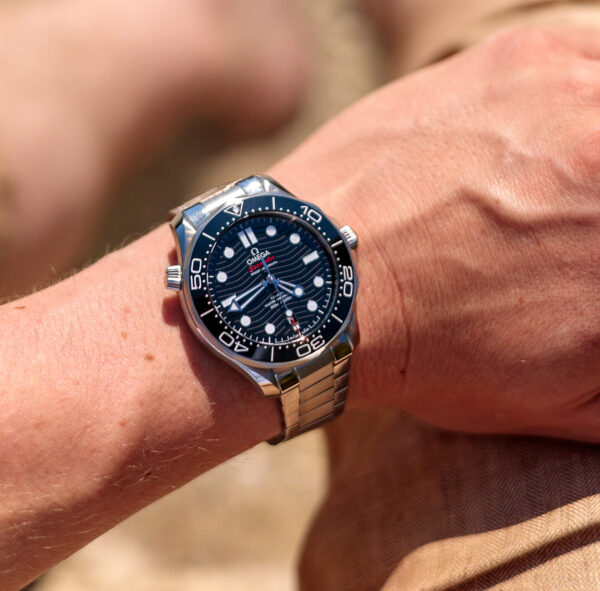
No Time to Die Version (210.92.42.20.01.001)
Speaking of tie-ins, this watch returns to its original place as a Bond watch with Daniel Craig’s final Bond film, No Time to Die. But it isn’t the off-the-shelf version with the ceramic wave dial. Omega designed a special version of the watch with input from Craig himself to create a watch that would look like a watch a member of the Royal Navy would wear. It’s made of titanium, not stainless steel, which makes it very lightweight on the wrist, and it uses aluminum (so it will fade) for the bezel and dial, both in a warm dark brown (sometimes called a tropical dial). The dial is flat, with no wave pattern, and it has no date window. One of the coolest things is that the numerals on the bezel are lumed, so they glow in the dark. It comes on a NATO strap (a classic throw-back to classic Connery Bond films, wherein Bond wore a Submariner on a NATO strap) or a Milanese bracelet. It’s priced in the $8-9,000 range, so it’s much more expensive than the standard issue model. Here’s a link to a search for the watch on eBay.


I’m a major fan of the Bond Seamaster, as I’ve written previously. If I had to get rid of everything and just pick one wristwatch to wear for the rest of my life, I wouldn’t hesitate; this is the one. There’s a lot to love, and the quarter century of history it has as well as its strong sales indicates that it will be around for a long while. I’m looking forward to the future Omega has in store for it. If you’re considering a great all-around Swiss watch, I highly recommend it.
(Help support this site! If you buy stuff through my links, your clicks and purchases earn me a commission from many of the retailers I feature, and it helps me sustain this site—as well as my menswear habit ;-) Thanks!)
If you’re just getting into tailored menswear and want a single helpful guide to building a trend-proof wardrobe, buy my eBook. It’s only $5 and covers wardrobe essentials for any guy who wants to look cool, feel cool and make a good impression. Formatted for your phone or computer/iPad so it’s not annoying to read, and it’s full of pretty pictures, not just boring prose. Buy it here.
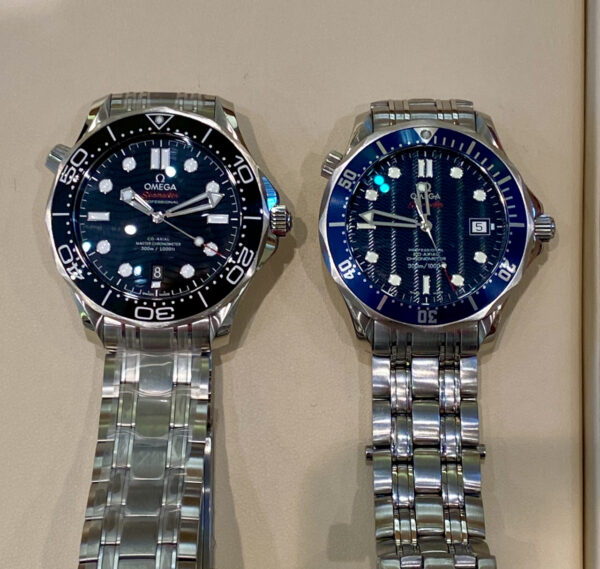
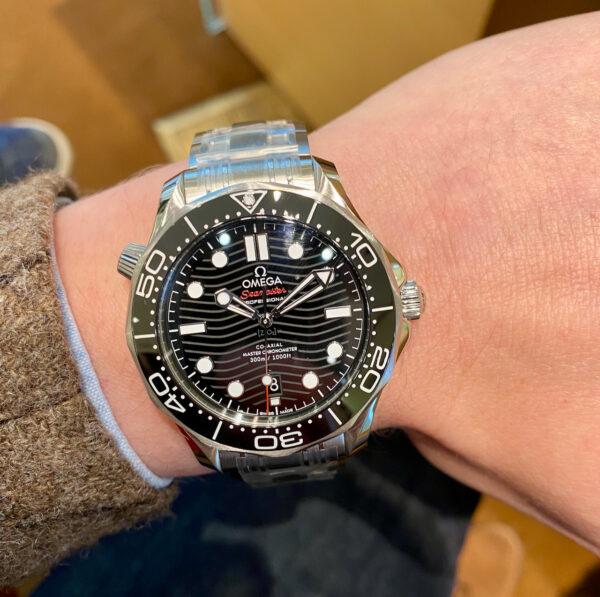
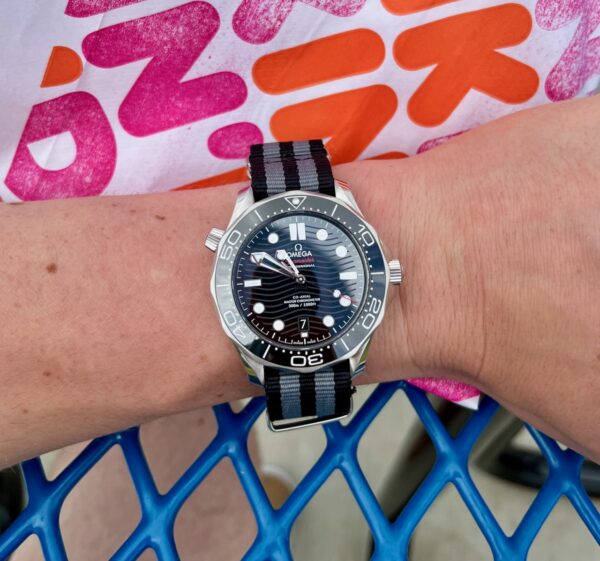

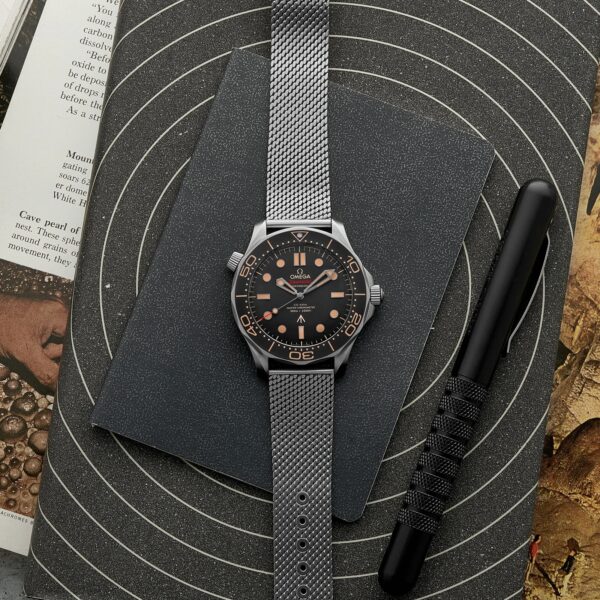



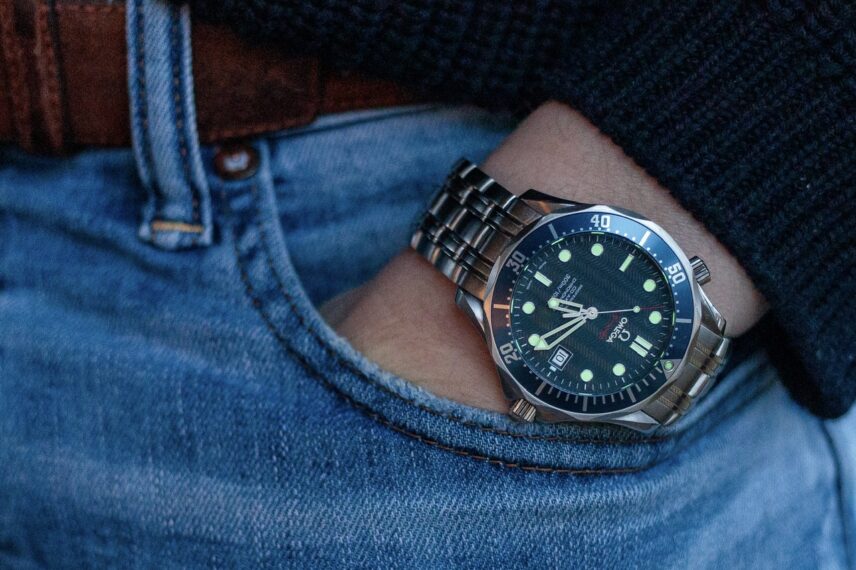
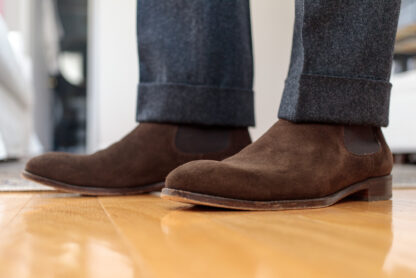


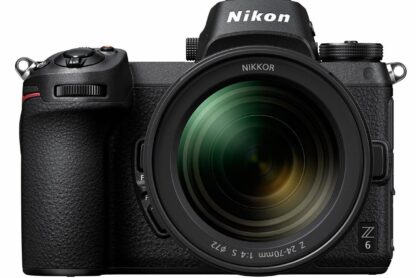
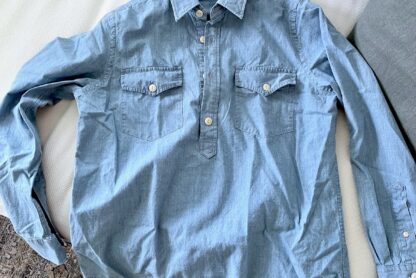
The Seamaster looks nice. How do you feel about the Speedmaster (Moon Watch) by comparison?
I absolutely love the Speedmaster Moon Watch. It would be an equally great contender as an “only watch,” although it’s much less water resistant which many people worry about (Omega says you can swim with it on, just don’t push the buttons; I wouldn’t risk it. Whereas with my Seamaster I wear even when showering and don’t think twice).
The Speedy has credibility and history, and they’ve been making them so long you can find one reasonably inexpensively. For instance, look for the 3570.50, which they made for like 20 years—doesn’t have the fancy box or the display caseback, but it’s the moonwatch on the 1861 caliber which has direct roots to the old caliber worn on the moon in the 60s, and can be found for a pretty great price if you hunt.
I personally will eventually buy the sapphire 3861 moon watch (the latest revision, just released in 2021, using the co-axial escapement; the sapphire because I want to see the movement on the case back mainly). My brother has the Speedmaster “First Omega in Space,” which was recently discontinued, and it’s an absolute gem.
Thanks for the thoughtful reply! I think I may split the difference and grab a Bulova Lunar Pilot to scratch the Speedmaster itch and go with a Seamaster as the one true luxury watch in my collection (when able to).
The Bulova is the one that started me on this road in earnest. I wrote about it last summer which you may have seen. It is a great, super accurate watch, though it’s big. But for the price it’s got a cool story and the design looks very Speedmaster-y. I like it on a NATO strap. I’d say get the model with no date when you look for them. It has the vintage Bulova word mark too and looks slightly cleaner on that account.
Love your fashion and writings!
Regarding a couple pieces you wrote, I just purchased a preowned Omega Seamaster Professional 300M. It’s the “transitional” model with the older wave dial, black and 41mm. Still adjusting to size as my previous watch I wore for 10 years was a 39mm Longines Hydroconquest. Keeping in mind I’m looking for that “one” black dial steel sports watch that is versatile, do you think the 36mm would’ve worked better than the 41mm (7″ wrist)? Thanks!
Congrats on the watch! It’s of course a personal preference but I’d say you’ll get used to the 41mm size quickly and it’ll feel normal. My wrist is a little smaller than yours actually (6.75”) and I think the 41 is perfect.
I know the feeling you’re experiencing though. I recently got the 37.5mm Planet Ocean, and wore it every day for a few weeks after getting it. But it had some issues, which required a factory service (thankfully it is still under the original 5 year warranty). So I sent it in, and went back to wearing the 41mm Seamaster. At first it seemed *huge*. But in just a few days I adjusted to its size again.
If you had an opportunity to try a 36mm model for yourself to compare side by side would be the best way to know for sure. But my opinion is that you’ll likely get used to the size and love it.
Thank you so much! So, last question…if you had option for one watch only would it be the 36 or 41 ?
For me, the 41mm. I haven’t tried the 36mm of this particular watch but the 41 is the canonical size so I like the proportions. And as a dive watch I think slightly bigger makes sense.
You’re awesome, thank you!
Thank you for this fantastic review. The pictures you’ve included are gorgeous and really capture well the ‘essence’ of this watch and its versatility. Very well done! I have the exact same watch and have owned it since February 2007 and love it. One thing that has blown me away with the Co-Axial escapement is the longevity of the service. I still have not needed to have it serviced. I took it in to an AD a couple years ago thinking it was just time to get it done was advised to just keep wearing it and bring it in when it stops keeping regular time, but otherwise continue to wear it. It’s still going! It really is a special piece and was my first “professional” watch purchase when I was 24 years old. I’ve since added an Omega Planet Ocean 8500 to my repertoire as well, but this Seamaster is the one I plan on handing down to my son at some point in the future.
It’s a pity an otherwise entertaining piece is ruined by bad research. Prince Harry doesn’t wear an Omega Seamaster; it’s Prince William. Harry wears a Rolex.
Ahh, thank you for the humble and polite correction!
A great write-up! I bought the 2220.80 SMP back in 2012. My first Omega and was a treat from my wife. At the time, the no waves ceramic SMP was just released. I was in a dilemma as to which one to choose. I’m a sucker for Bond so I went with the 2220.80. At first I thought I was gonna regret not getting the more “modern” update with the ceramic bezel and all, but alas, that feeling went away quickly when I begun to realise that the 2220.80 was a wise choice. It’s a mixture of old and new. And the waves dial alone makes a difference. Almost 11 years and I’m still wearing the watch today. Wearing it now as I’m typing this. Timeless.
Great article! Super informative and helpful. I’ve always loved the seamaster and am looking to finally pull the trigger. My biggest concern is that it’ll look too big on my 6.5” wrist. As it seams like every 6 years they release a new generation does it make sense to hold off?